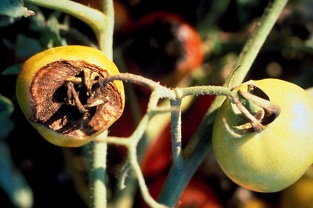
Features
Production
Research
Saskatchewan growers learn about “reduced risk” products
January 16, 2009 By Myron Love
 January 16, 2009 – During last fall’s Saskatchewan Vegetable Growers Association
January 16, 2009 – During last fall’s Saskatchewan Vegetable Growers Association
conference and trade show, Ron Howard, an Alberta Agriculture and Rural
Development scientist in plant pathology, helped bring growers in that
province up-to-speed on recent registrations under the Federal
Pesticide Risk Reduction program.
January 16, 2009 – During last fall’s Saskatchewan Vegetable Growers Association conference and trade show, Ron Howard, an Alberta Agriculture and Rural Development scientist in plant pathology, helped bring growers in that province up-to-speed on recent registrations under the Federal Pesticide Risk Reduction program.
 |
| An example of early blight on tomatoes. |
“Reduced risk” applies to uses of active ingredients that are registered through NAFTA’s Joint Review Program for Reduced Risk Pesticides and the Pest management Regulatory Agency’s (PMRA) Initiative for Reduced Risk Pesticides, explained Howard. The designation doesn’t mean that there is no risk with the product, but rather that the risk profile is lower than similar products, he added.
Reduced risk products can include conventional chemical pesticides, biopesticides, microbials, pheromones and other USEPA-designated biopesticides, Howard explained.
He reported that several new pesticides were registered in 2008. Among them were:
- Fluazinam (Allegro 500F Agricultural Fungicide) for control of late blight on potatoes, white mold on snap beans and clubroot on mustard greens.
- Pyraclostrobin (Cabrio EG) for control of purple blotch and downy mildew on bulb vegetables; alternaria and gummy stem blight, anthracnose and downy and powdery mildew on cucurbits; early blight and anthracnose on field pepper, tomato and eggplant; and alternaria blight, powdery mildew and cercospora leaf spot on root and tuber vegetables.
- Gliocladium catenulatem strain J1446 (Prestop Biofungicide WP) suppresses root and stem diseases caused by pythium, rhizoctonia, botrytis and fusarium species on certain vegetable, herb and ornamental crops.
- Bacillus subtillis strain MBI 600 (Pro-Mix TA with Biofungicide) is effective against damping-off and root rot diseases caused by pythium on tobacco and vegetable transplants.
Mono- and di-potassium salts of phosphorus acid and Mindipropamid received conditional registrations under the Pest Control Products Regulations. Mandipropamid (Revus) controls or suppresses downy mildew on Brassica and leafy vegetables, cucurbits and grapes; phytophthora blight on peppers; late blight on tomatoes and potatoes; and blue mold on leafy vegetables. The mono- and di-potassium salts suppress late blight and pink rot storage infections on harvested russet-skinned potatoes and potatoes intended for processing.
As well as the new, full-use “reduced risk” pesticide registrants, there were also 21 minor use registrations covering 34 crops or crop groups.
Howard also identified several potential new “reduced risk” fungicides for organic producers. Among them were Heads-Up Plant Protectant (an extract of Chenopodium quinoa) for seeding diseases on peas and seed piece decay and silver scurf on potato; Serenade (bacillus subtillis) for controlling late blight and silver scurf on potato as well as late blight on tomato and downy mildew on cucurbits; Sonata (bacillus pumilus) for late blight on potato and tomato and downy and powdery mildew on cucurbits; and Contans (Coniothyrium minitans) for treating white mold (sclerotinia) on carrots and beans.
Print this page